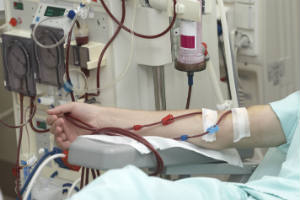Hemodialysis Patient Story: How Vascular Access Surveillance Technology Helps
Most hemodialysis patients aren’t like Lori Clark. While most patients take the usual steps to stay healthy and attend their hemodialysis appointments, Lori goes a step further — she investigates and experiments based on what she learns at her dialysis sessions.
While that might seem odd, doing so has helped her take better care of her vascular access. She couldn’t do it, however, without the help of Transonic’s HD03 monitor, which her clinic uses to monitor its patients’ vascular access flow.
“I didn't know it could help me,” Lori said of the HD03. She was curious about what it did after her nurse wheeled it over to her.
“I asked ‘What is it saying?’ The nurse told me, ‘Well, it says your number is 1400.'" The nurse proceeded to tell Lori that this was good, because below 600, that means you have narrowing or stenosis that can lead to a clot. That communication helped her feel empowered.

“I realized that if I went down to 600, they were going to operate on me. And it's painful. So, I need to take care of my graft. So every month I watch the numbers, and I always ask about them. But most patients don’t know how to use this information.”
Using the Vascular Access Surveillance Numbers to Experiment
When Lori received lower numbers than she would have liked during a couple of sessions, she began to experiment.
“When the numbers started going down, I knew something was wrong,” she said. So, she wondered if there was something she was doing that could be affecting her access.
It turns out she was wearing a tight fitting jacket, and by removing the jacket, her number went back up.
“If the jacket's not obviously that tight, a clot will build up in time,” Lori surmised. “And you won't know where it came from. This is all guesswork for a patient because there's no way to know for sure. Having the Transonic machine helps a lot. Otherwise there will be no basis for me to even guess anything. It’s helped me take better care of my access.”
Tight fitting clothing or clothing bunched up to uncover the access site can act like a loose tourniquet that impedes the blood flow in the vascular access circuit including the draining veins that lead back to the heart.
“Because most patients don't know what the machine is for, they don't care. They just play it by ear, like, "Oh okay. My graft is good. Okay. It's not." They don't know that they can actually do something about it,” she said.
Without the vascular access surveillance equipment, Lori notes, patients are commonly subjected to painful fistulagrams to see if their grafts are blocked or narrowing.
“This medical procedure is expensive and painful. Transonic Monitoring equipment will painlessly give a monthly report on the blood flow inside the dialysis access,” she says.
Lori regularly blogs about her hemodialysis experiences with the HD03 and hopes to educate fellow patients about its importance and to empower them.



